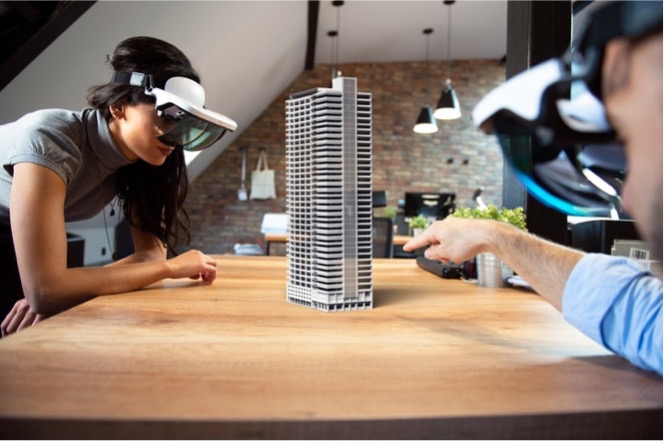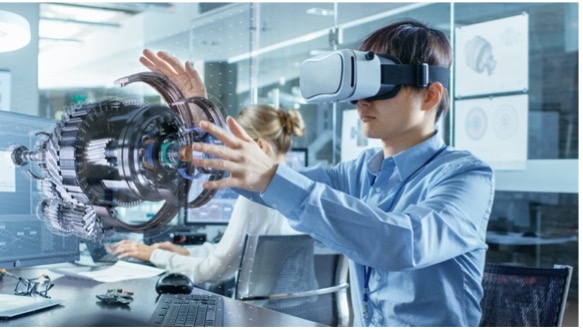Virtual Reality (VR) technology allows a person to be immersed in a three-dimensional virtual, yet safe, environment. That virtual world may simulate a real-world situation or provide an experience completely out of this world. Participants experience the virtual world by using VR devices, such as headsets, glasses, gloves, and even full bodysuits.
PCMag.com describes it as “A fascinating way to travel using nothing more than the power of technology. With a headset and motion tracking, VR lets you look around a virtual space as if you’re actually there, or play a game as though you’re really in it. It’s been gaining traction in recent years thanks to compelling games and experiences…”

In fact, according to a recent report by International Data Corporation (IDC), the global virtual reality market size was valued at USD 15.81 billion in 2020 and is expected to grow at a compound annual growth rate (CAGR) of 18.0% from 2021 to 2028.
The potential growth of this market is amplified by the surge of COVID19 and the overall movement of working remote, where “consumers and employees stay indoors and look for AR and VR solutions as ways to collaborate with colleagues and families”.
But the main reason for its growth is the increasingly vast array of applications and usages. The most common are in the consumer space with immersive games where the players can experience defending earth from an alien invasion… or defending an alien world from a human invasion. Beside games, we can see a growth potential in other applications like training and business.
VR in Training
The applications for VR are not only fun and games. It also provides some very sophisticated training possibilities that can substantially impact society. For example, medical students and veteran practitioners alike are leveraging VR to practice and learn new surgeries and procedures well before they ever pick up a scalpel. Military organizations around the world, such as the Infantry Training Centre in Catterick, North Yorkshire, UK are using VR for training to match real actions on the battlefield. VR can enhance sports training and viewing experience for players, coaches/trainers and fans. Coaches can use VR to show a play from any angle for deeper analysis as well as demonstrate new plays and strategies with the team and get fans closer to the action by watching a game with a VR headset from anywhere in the world.
VR in the Business World
Besides training and education, several industries are leveraging VR in new and exciting ways. For instance, to save time, real estate agents can take their clients on a virtual tour of their next home. The tours can be self-guided where the client walks through the home at their own pace or as a guided tour using a promotional video that can be available to anyone interested in a home. On the commercial side, architects and developers can walk potential stakeholders such as clients and city planning/zoning officials through a new skyscraper that will define the skyline for the next 100 years.
VR is also empowering engineers with the ability to experiment with new designs and approaches well before a prototype is even considered. This allows engineers in industries such as automotive and aerospace to detect and correct errors early and to see how equipment will perform in a virtual environment before it hits the road, the sky or even outer space.
There is also growing consumer demand for AR and VR features in the online shopping experience. These technologies can provide a middle ground between e-commerce sites and brick and mortar shops, offering a solution to the limitations of both, and ultimately providing an immersive customer experience.
VR and Storage
CNET reports that today’s VR games are better than ever, but because of computing power and storage, users have to decide whether they want a headset that plugs into a PC or console, or choose a standalone option. CNET says more evolutions are on the way. For instance, companies such as Qualcomm (which makes the chips inside most self-contained VR headsets, including the new Quest 2) are building new chips that point to a wave of better standalone headsets at lower prices — including ones that plug into your phone.
These new systems will have to evolve quickly because as demand increases, content will also evolve to become more complex, sophisticated and higher resolution. VR systems with microSD memory cards will be able to handle not only the massive file sizes involved, but also the fast throughput required for 4K and 8K-level content. VR systems that enable this higher-grade content will benefit from the new SD Express cards based on SD 7 and SD 8 specifications using PCIe®/NVMe™ architectures beside the standard SD interface.
With up to 1 gigabyte per second (GB/s) or up to 4GB/s provided by SD Express SD7 and SD8, respectively, and usage of the advanced market proven NVMe protocol, SD Express is designed to help product and content designers stay ahead of increasing imaging and data storage requirements by not having to worry about read/write speeds and storage needs. They should also be aware that SD Express is backwards-compatible with older SD devices through the SD UHS-I interface of up to 104MB/s.
One of the most common issues for VR content developers and users of VR headsets is the amount of storage that is required for the newest and best VR games and applications. For example, one of the most common complaints against the newest version of the popular Oculus Quest 2 is lack of an expandable storage option. In fact, AndroidCentral praised it for its amazing performance and low price, however specifically noted that neither version of the VR headset included a microSD slot for expandable storage.

By including microSD card slots, VR systems, especially the standalone headsets, are able to take advantage of the newest applications for business, gaming and entertainment without ever running out of storage.
Yosi Pinto is chairman of the SD Association. Pinto can be reached at Yosi.Pinto@wdc.com.
SD trademarks are owned and licensed by SD-3C LLC.
PCI Express® and PCIe® registered trademarks of PCI-SIG®.
NVM Express™ and NVMe™ are trademarks of NVM Express, Inc.
© 2021 SD Association. All Rights Reserved.




